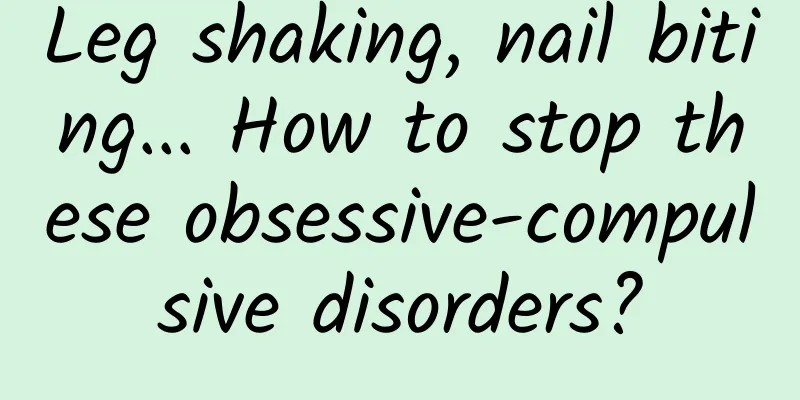Leg shaking, nail biting... How to stop these obsessive-compulsive disorders?

|
Leviathan Press: I remember a primary school classmate who had the habit of biting his nails, and later he even tore off the skin around his nails... After work, it is also common to see people shaking their legs and twirling their hair. In fact, as long as these compulsive behaviors are not serious enough to cause trouble to you, there is no need to pay much attention to them. Otherwise, even if you use the various guidance and suggestions from the experts in this article, it is easy to fall into the "white bear theory": the more you try not to think about the white bear, the more the image of the white bear will be deeply rooted in your mind. Even when we are alone, we may need to break these habits. But how did these habits arise? We talked to a number of experts to discuss some possible ways to kick these habits. Flint Espil Clinical Assistant Professor of Psychiatry and Behavioral Sciences at Stanford University, researching the causes and treatment of tic disorders, obsessive-compulsive disorder, and body-focused repetitive behaviors Foot tapping, nail biting, and hair twirling are what we call body-focused repetitive behaviors. Of course, there is a limit: for some people, these behaviors are not worth taking seriously, but for others, they may cause serious problems in their lives. If these behaviors become a problem, many people have found a standard method to control them that works. It’s a three-step behavioral therapy called habit reversal training, which was developed in the early 1970s and has been underway for nearly 50 years. The first step is to identify where and when these behaviors occur. I encourage people to keep a journal: when they catch themselves (or others catch them) doing these behaviors, they can note where they were, what they were doing or thinking about, and any other factors associated with them. They should also note any other behaviors in the potential chain of behaviors that led to the problem (e.g., checking or rubbing nails, running hands through hair, searching or rubbing skin for "blemishes," etc.). This provides people with some insight into these behaviors, and often also increases awareness of the behaviors themselves. Perhaps they are stressed out about an important exam the next day or a big challenge at work, and fiddling with their hair is a way to release stress. Or perhaps they are more likely to engage in these behaviors before bed or when they are bored. Once you know when and where it happens, you can change these variables to reduce the likelihood of these behaviors. If these behaviors relieve stress, I encourage people to seek out other practices to relieve stress, such as meditation, relaxation breathing, exercise, or other helpful methods. If these behaviors relieve boredom or restlessness, people can place objects in their environment to keep their hands busy, or they may need to find another way to take breaks to prevent the stress of sitting. The second part of habit reversal training is to create a competing behavior—a competing behavior that will interfere with people’s hair-twisting, nail-biting, or leg-shaking. For hair-twisting, a common competing behavior is to cross one’s arms across one’s chest or clench one’s fingers together once one finds one’s hands about to start twirling their hair again. We usually tell people to maintain this competing behavior for about a minute or so, or until the urge to engage in the problematic behavior subsides. The third part of habit reversal training is social support. People need help from family or others who can prompt the use of replacement behaviors if they notice body-focused repetitive behaviors. This is especially helpful for people who don’t understand when and where their problematic habits occur. If you decide to do this, make sure to have an agreed-upon method of prompting to minimize unnecessary arguments. Carol Mathews Professor and Vice President for Strategic Development, Department of Psychiatry, University of Florida, Director of the Center for Obsessive-Compulsive, Anxiety, and Related Disorders Habits are voluntary movements, but they are done semi-consciously. We don’t say “I’m going to bite my nails today”, we just do it automatically. At the same time, these behaviors are under people’s control. Therefore, the first thing to do is to make people fully aware of these behaviors. It's easy to say that once people are fully aware of their bad habits, they can "stop." However, it's hard to do. Often, the habit is hard to break. In such cases, it's necessary to create a barrier. If you have a habit of biting your nails, you can apply bad-tasting nail polish or vinegar to your nails. If you have a habit of stamping your feet, you can put some nails on the soles of your shoes. Taste and sound can help turn the habit into a fully conscious behavior. The next step is to consciously focus on replacing these behaviors for limited periods of time. If people find themselves biting their nails in certain situations, such as watching a movie, they can consciously do something else in those situations. I tell my patients who have nail-biting problems to learn knitting because they can do that while watching TV. If people have a problem with foot-stomping and leg-shaking, they can try crossing their legs so they don’t keep stomping and leg-shaking. If you’re in an environment where you can’t sit with your legs crossed or knit, there are more techniques. If you’re in a meeting, you can plant your feet firmly on the ground and try to plant your feet for 60 seconds; or you can sit on your hands; or pick up a notepad. You can also consciously say: OK, I’m not going to bite my nails or tap my feet for the next 60 seconds, and then allow yourself to move your hands and feet again. Sometimes 60 seconds is enough, and you don’t do it again, and you’re busy doing other things. These habits are distinct from tics because people can control them. Teaching someone with a tic disorder to suppress a tic is an active behavior: We can use similar methods to combat these behaviors, but a tic is a bit like a sneeze, where people may know a sneeze is coming, but they may not be able to stop it. We can learn techniques to recognize when a tic is coming and support or modify it, but it is an involuntary behavior. Katharine Phillips Professor of Psychiatry, Weill Cornell Medical College, New York Foot tapping, nail biting, hair twirling and other similar behaviors are sometimes called body-focused repetitive behaviors. Many of these behaviors are simple habits that are not usually a problem and do not require treatment. However, when they occur repeatedly, are difficult to stop and cause significant distress or impairment in functioning, they rise to the level of a mental health disorder. In this case, I recommend treatment by a professional, which can be very helpful. In the diagnostic manual for this field (DSM-5), the following two problematic types of repetitive behaviors directed at the body are classified as separate mental health conditions: trichotillomania (hair pulling disorder) and excoriation (skin picking disorder). In some cases, these disorders are serious, for example, they can cause extensive hair loss or serious skin infections. Typically, the mainstream treatment for these types of problems is a method called habit reversal training. This treatment usually entails awareness training (through daily self-monitoring and identifying triggers for the undesirable behavior), stimulus control (modifying or avoiding triggers), and developing a "competing response" (doing something else with your hands, like squeezing a ball, or clenching your fist). Some therapists add elements like relaxation training or therapy to help patients better handle difficult emotions. Habit reversal training can also be used for less problematic body-focused repetitive behaviors, such as those that are annoying. For behaviors that are more difficult to control, the natural supplement NAC (N-acetylcysteine) can reduce hair pulling, skin picking, and similar repetitive behaviors directed at the body. NAC can be started at 600 mg per day and then gradually increased to 1200 mg twice a day, or even 1800 mg twice a day if needed. Patients should consult their doctor for dosage recommendations. If patients’ symptoms cause severe distress or functional impairment, serotonin reuptake inhibitor (SRI) medications, such as fluoxetine (Prozac), sertraline (Zoloft), or escitalopram (Lexapro), can also be tried. These are widely used prescription medications that can be effective in addressing severely distressing, body-focused repetitive behaviors. If you have other symptoms or disorders that might improve with an SRI (such as depression, obsessive-compulsive disorder, or body dysmorphic disorder), then the option of trying an SRI medication may be more appealing. Another class of medications called atypical antipsychotics (but they can actually effectively treat a very wide range of symptoms) may also help, but these are usually reserved for more severe repetitive behaviors. As with all medications or supplements, the prescribing clinician should carefully weigh the pros and cons of each option for each patient. (Leviathan Tips: Do not try medication without authorization, please seek medical attention if necessary) Antonia Caretto A clinical psychologist with extensive experience in treating children, adolescents and adults with obsessive compulsive disorder While people may think of tapping their feet, biting their nails, and twirling their hair as “natural habits that happen when you’re stressed,” the causes and solutions to these habits may be different. Each of these behaviors has the potential to be exacerbated by stress, so good stress management skills are a reasonable intervention to consider first. Stress management includes yoga and relaxation, breathing exercises, and mindfulness, but can also include positive social interactions, adequate sleep, a healthy diet, and regular exercise. Habitual leg-twitching may be caused by anxiety, but in some cases it may be a side effect of medication or caused by a neurological condition such as leg nerve syndrome or dementia. A psychologist will be able to help you identify when you are leg-twitching and suggest possible treatment options to stop the habit. Hair pulling is often a behavior that those who suffer from trichotillomania have very specific treatments for. For those who already suffer from the disorder, people can try to find other things to keep their hands out of their hair, or even temporarily use a barrier (baseball cap) to make the habit more conscious and easier to break. Nail biting is considered a repetitive behavior directed at the body, often driven by perfectionism. If this is the case, the patient believes that the nails do not look or feel perfect, and the nail biting is an effort to fix the imperfection. Cognitive behavioral therapy that addresses thinking errors and compulsions is necessary to resolve nail biting. Each of these observable behaviors may also be a symptom of a motor tic. A genetic predisposition or susceptibility is often found in people with tics (those who have tics in their family). People with tics often feel an urge or feeling before the tic, but can alleviate it by learning competing behaviors. For each behavior, raising awareness of it is the first step, and finding alternative behaviors is a reasonable attempt. Avoiding situations that trigger these behaviors can help, so taking it easy is highly recommended. Self-reflective cost-benefit analysis of the behavior can help with change. Setting small, reasonable, and achievable goals is essential to any behavior change program, and support from others can also help. Seeking help from a mental health professional with a strong background in applied behavior analysis and cognitive behavioral therapy can also help patients resolve their problems. Sara O'Brien Associate Professor of Psychology at Knox College, whose primary research interests include the assessment, classification, and diagnosis of mood and anxiety disorders Research shows that rewarding yourself for a behavior increases the likelihood that behavior will occur again. Set a small goal to reward yourself every time you break a habit—if you love M&Ms like I do, maybe you could make it a point to reward yourself with a handful of M&Ms if you don’t fiddle with your hair during a meeting. Over time, you’ll be less likely to fiddle with your hair. It is also important to note that while these habits are very common and usually harmless, some severe forms can lead to serious physical, psychological, and social consequences. For example, trichotillomania and skin picking are clinical disorders that should be treated by professionals with experience in these conditions, and there are many effective treatments that are based on the principles described above. Finally, what triggers these behaviors in the first place? Internal thoughts or emotions (e.g., anxiety, excitement, anger, boredom) and/or external circumstances (e.g., specific people, places, or situations) can make these behaviors worse. Self-monitoring can help people identify what the triggers are so that they can address them. If you find that you are twirling your hair during meetings because you are stressed out, it may be more important to not only reduce the twirling, but also address the causes of your stress. Margo Thienemann Clinical Professor of Psychiatry and Behavioral Sciences, Stanford University You might be shaking your legs because you're anxious or impatient, but for some people who have trouble focusing, it can be a way to help block out other distractions. This behavior might annoy others enough that they have to stop. But the act of shaking your legs may be enough and effective motivation in itself. If you use it to help you focus, and you're not disturbing anyone, then maybe you don't have to stop. If you tap your leg when you're anxious or impatient, try to think about why that is and whether these behaviors are what you need - what's going to happen after you tap your leg? How important is it? How time-sensitive is it? What can you control? Is it outside of your control? What are the possible outcomes? Once you've looked at it carefully, you can practice mindfulness meditation or distract yourself from what's bothering you instead of tapping your leg. Nail biting is similar. It's not a good idea from any perspective: It's not socially acceptable, it's not an effective beauty treatment, it can cause damage to nails and cuticles, and it puts a person at increased risk for illness (especially now, with the coronavirus pandemic). If it's a habit, work on breaking it. Treatment guidance, resources, and support for nail biting and some other repetitive, body-focused disorders are available at the Trichotillomania Learning Center/TLC Foundation for Body-Focused Disorders. I think hair twirling can be considered a similar behavior to leg shaking and can be annoying to those around you. If it is a habit that causes hair to break or fall out, then I would recommend that people who engage in this behavior seek help from the above agencies. Tics are common, usually short-lived, and usually occur in school-age children, more often in boys. If they persist for more than a month, a professional evaluation is needed to determine if the tic is related to other conditions, such as attention deficit and hyperactivity disorder (ADHD), obsessive-compulsive disorder, or dyslexia. If tics develop suddenly in a child and are accompanied by other severe mood symptoms, sleep difficulties, bedwetting, or frequent urination, they may be a symptom of Pediatric Autoimmune Neuropsychiatric Disorders Associated with Streptococcal Infections. If this happens, it is important to seek a diagnostic evaluation from a healthcare provider to identify the cause of the infection and treat it aggressively. By Daniel Kolitz Translated by Adamache Proofreading/EDI Original article/gizmodo.com/how-do-i-stop-tapping-my-foot-biting-my-nails-or-twir-1844453292 This article is based on the Creative Commons Agreement (BY-NC) and is published by Adamache on Leviathan The article only reflects the author's views and does not necessarily represent the position of Leviathan |
>>: New idea for epidemic prevention: giving vaccines to wild animals
Recommend
Is a 22mm ovarian cyst serious?
Ovarian cysts are very common in clinical medicin...
How to remove the fishy smell of chicken gizzards? Are chicken gizzards the same as chicken gizzards?
Chicken gizzards are often used as ingredients fo...
Will dogs get angry if they eat too much Vespa nutritional paste? How to distinguish the authenticity of Vespa nutritional paste?
Nutritional paste is a common pet food in life. I...
What is the best way to wash yellow leucorrhea?
Every woman wants to be a clean and refreshing pe...
What should I do if I have green vaginal discharge?
When women's lifestyle and work pressure are ...
How to maintain after hysterectomy?
Every woman wants to be beautiful and healthy at ...
What are the benefits of eating hot dry noodles with sesame paste? How to make sesame paste for hot dry noodles
Although sesame is small, it contains great energ...
What is uterine cyst?
Uterine cysts are also called uterine leiomyoma, ...
What are the dangers of candidal vaginitis?
For women, we all know that candidal vaginitis is...
Wedbush: iPhone 15 series pre-orders increased by 10% compared to 14, and the Pro series is more popular
According to recent news, the entire iPhone 15 se...
Causes of hydrosalpinx on one side
When women feel uncomfortable, they need to have ...
Pain in the left pelvic bone of a woman
What is different about pelvic pain is that women...
I ate passion fruit and my period stopped
Passion fruit is a fruit that is very popular onl...
What is the cause of vulvar skin ulceration?
Vulvar skin ulcers may be caused by vaginitis or ...









